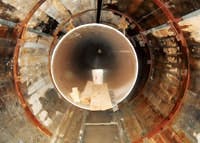The city of Mississauga is located in southern Ontario, Canada, on the shores of Lake Ontario. This suburb of Toronto is located in the Regional Municipality of Peel, which is Canada’s sixth-most populous municipality. Peel consists of the cities of Brampton and Mississauga and the town of Caledon, for a total of 1.3 million residents.
The region is responsible for the services and infrastructure related to water delivery and wastewater treatment, waste collection and disposal, and regional roads, among others. Peel has undergone a change over the past few decades. Population growth and commercial development have converted what was mainly a rural area into an urban environment.
The Cooksville Creek Trunk Sanitary Sewer services the downtown area of Mississauga. This pipeline was reaching its capacity limits and the region wanted to redirect some of the flow into the Canadian Pacific Railway Trunk Sanitary Sewer. In order to do this, a new diversion trunk sewer was constructed. The Cooksville Creek Trunk Sanitary Sewer Diversion project consisted of the construction of a 48-in.-diameter sanitary sewer within an 8-ft-diameter tunnel. The Region of Peel put the project out for bid in fall 2009 and construction began in December 2009. McNally Construction Inc. of Hamilton, Ontario, was awarded the contract.
Design Considerations
The Region of Peel utilizes an approved listing of pipe materials when selecting pipe for projects. McNally proposed the use of Hobas centrifugally cast, fiberglass-reinforced, polymer mortar pipe (CCFRPM) for the entire length of the project, even though it was not on the approved material list.
“We suggested Hobas pipe because we had used it previously in the States, and knew it was a good product and the right one for this job. It was also priced competitively, and the ease of installation compared to CPP was a huge advantage,” said Adam Stremcha, project manager for McNally.
After research by the consulting engineer and the region, it was decided to use CCFRPM in the areas of the pipeline with the greatest risk of corrosion: from manhole two to manhole three and from manhole three to manhole four. It is common for wastewater lines to create hydrogen sulfide as a byproduct. Hydrogen sulfide converts into sulfuric acid, which corrodes certain pipe materials and lessens the life of the pipeline.
“CCFRPM pipe is inherently corrosion resistant, providing our customers with a long, maintenance-free life,” said Rene Garcia, engineering supervisor for Hobas Pipe USA.
Long-Term Solution
Hobas supplied 3,500 ft of 48-in., 46-stiffness CCFRPM pipe. The pipe was factory assembled with FWC couplings on one end of each pipe to facilitate use in the field. Angular rotation of the joint allowed for negotiation of tight radius curves in the line. Based on project requirements, pipe can be supplied in the standard 20-ft sections or shorter lengths.
Straightforward Installation
Trenchless methods were preferred for this project due to its location in an urban environment. The new line ran from Central Parkway East and Burnhamthorpe Road to the west side of Hurontario Street. The depth ranged from 26 to 52 ft, allowing for clearance of the existing sewers and for the line to cross below the two branches of Cooksville Creek. A tunnel-boring machine (TBM) excavated the tunnel, and steel ring beam and wood lagging tunnel was installed to maintain support. A single-shield Lovat TBM was used to bore through the Georgian Bay shale.
“After using [the pipe] on the Cooksville Creek Project, I would say it performed extremely well from a supply and installation standpoint,” Stremcha said. “I believe our installation rates were almost double that of the other pipe material used on the project. It was easy to manipulate and join in the tunnel.”
The Region of Peel allowed CCFRPM to be used for this project on a pilot basis. The product and its performance are being continuously monitored and evaluated.
Download: Here

